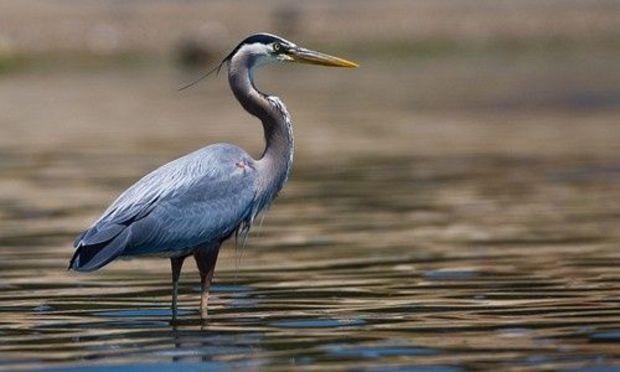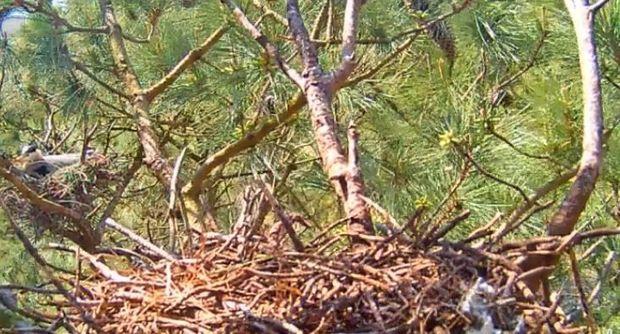The Chesapeake Conservancy has just launched their latest wildlife webcam: the Great Blue Heron Cam. The Conservancy also has a
Peregrine Falcon Cam on the 33rd floor of the Transamerica skyscraper in Baltimore City, as well as an
Osprey Cam.

According to the
Chesapeake Bay Program, the great blue heron is a tall, bluish-gray wading bird with a long, pointed bill and a graceful, S-shaped neck. They grow to four feet tall with a six to seven foot wingspan, but only weigh five to six pounds due to hollow bones. Great blue herons live year-round in marshes and wetlands throughout the Chesapeake Bay region, and can also be found on freshwater lakes, ponds, and impoundments. They eat mostly fish, but will also feed on insects, amphibians, crustaceans, and other small animals. Herons will nest and breed in colonies, called rookeries, with other herons. Rookeries are located in isolated areas such as wooded swamps and small islands, where human and predator access is limited. Breeding may begin as early as February, with new breeders continuing to arrive at the colonies well into May.
From the Chesapeake Conservancy:
A private homeowner (on Maryland's Eastern Shore) contacted the Conservancy expressing an interest in sharing the rookery located on their property with the world via a webcam. For the last ten years, the property has been home to between 10 and 12 nests, and as many as 50 herons, 100 feet off the ground in loblolly pine trees. We are thrilled with this chance to share these majestic birds with the public. We often see great blue herons soaring in the sky or hunting fish by the water’s edge, but rarely do we get to see them up close and at home in their rookery. We are also very grateful to the homeowner who is lucky enough to have this magnificent habitat in their backyard and is willing to share it with the world. The homeowner has named the couple “Rell & Eddie” after the surfers Rell Sunn and Eddie Aikau, both deceased but not forgotten."

The latest cam was made possible through donations to a
GoFundMe campaign; the Chesapeake Conservancy raised $6,629 through the fundraising site. Click to
chesapeakeconservancy.org/blue-heron-webcam to observe these graceful birds up close. Two nests can be seen on the camera; one is home to two herons incubating their eggs, due to hatch in mid-April. The Conservancy believes that the nest in the foreground is serving as a "supply closet" for herons in the rookery to take sticks back to their own nests.
 According to the Chesapeake Bay Program, the great blue heron is a tall, bluish-gray wading bird with a long, pointed bill and a graceful, S-shaped neck. They grow to four feet tall with a six to seven foot wingspan, but only weigh five to six pounds due to hollow bones. Great blue herons live year-round in marshes and wetlands throughout the Chesapeake Bay region, and can also be found on freshwater lakes, ponds, and impoundments. They eat mostly fish, but will also feed on insects, amphibians, crustaceans, and other small animals. Herons will nest and breed in colonies, called rookeries, with other herons. Rookeries are located in isolated areas such as wooded swamps and small islands, where human and predator access is limited. Breeding may begin as early as February, with new breeders continuing to arrive at the colonies well into May.
From the Chesapeake Conservancy:
According to the Chesapeake Bay Program, the great blue heron is a tall, bluish-gray wading bird with a long, pointed bill and a graceful, S-shaped neck. They grow to four feet tall with a six to seven foot wingspan, but only weigh five to six pounds due to hollow bones. Great blue herons live year-round in marshes and wetlands throughout the Chesapeake Bay region, and can also be found on freshwater lakes, ponds, and impoundments. They eat mostly fish, but will also feed on insects, amphibians, crustaceans, and other small animals. Herons will nest and breed in colonies, called rookeries, with other herons. Rookeries are located in isolated areas such as wooded swamps and small islands, where human and predator access is limited. Breeding may begin as early as February, with new breeders continuing to arrive at the colonies well into May.
From the Chesapeake Conservancy:
 The latest cam was made possible through donations to a GoFundMe campaign; the Chesapeake Conservancy raised $6,629 through the fundraising site. Click to chesapeakeconservancy.org/blue-heron-webcam to observe these graceful birds up close. Two nests can be seen on the camera; one is home to two herons incubating their eggs, due to hatch in mid-April. The Conservancy believes that the nest in the foreground is serving as a "supply closet" for herons in the rookery to take sticks back to their own nests.
The latest cam was made possible through donations to a GoFundMe campaign; the Chesapeake Conservancy raised $6,629 through the fundraising site. Click to chesapeakeconservancy.org/blue-heron-webcam to observe these graceful birds up close. Two nests can be seen on the camera; one is home to two herons incubating their eggs, due to hatch in mid-April. The Conservancy believes that the nest in the foreground is serving as a "supply closet" for herons in the rookery to take sticks back to their own nests.